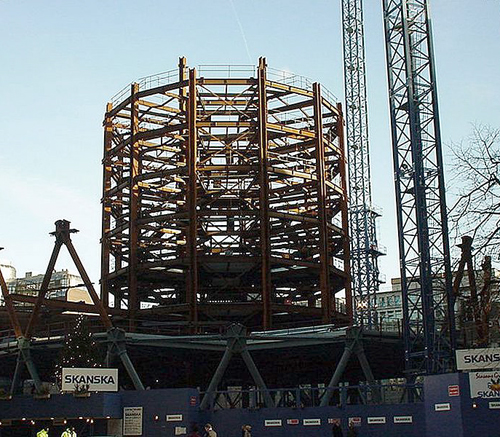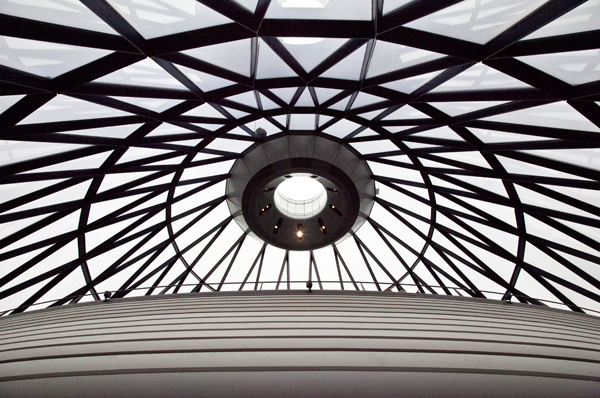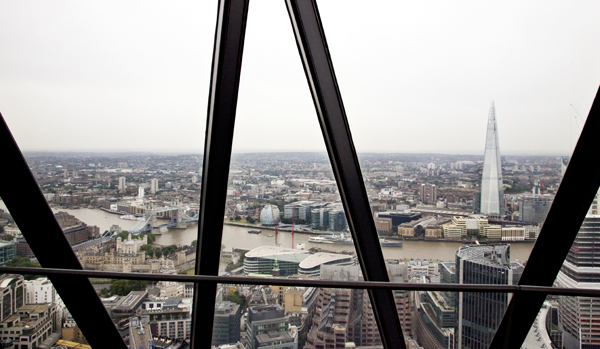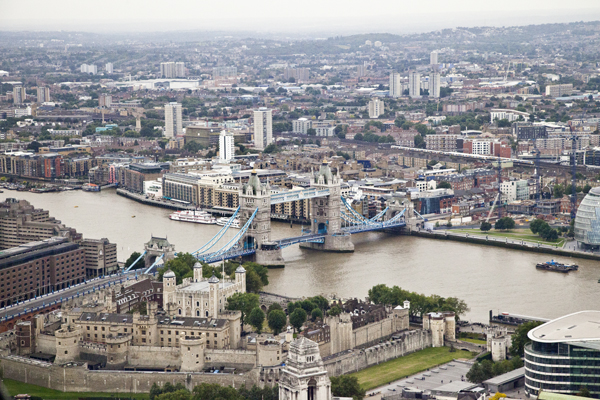Had the sight lines that span across London not been so vigorously put in place by government officials, our present city’s skyline would indeed look very different from what it currently is, and more than likely not for the better. Laws are in effect to prevent the obstruction of key vistas when viewed from high vantage points such as Richmond and Hampstead. The obvious suspects are St. Paul’s Cathedral and the Houses of Parliament, both venerated sites of interest in the heart of London that makes our skyline so unique and identifiable. This is also how Canary Wharf can get away with numerous high-rises but not the City of London. 30 St. Mary Axe (originally called the ‘Millennium Tower’) was one such victim with its original plans scuppered for a much smaller and sober rendition. Quite right too. For it’s sizeable enough to be used as a navigational tool around the city, yet not presumptuous enough as to detract from the kaleidoscope of neighbouring landmarks such as the Lloyds Building, Bank of England, Barbican Centre, Leadenhall Market, Monument, Tower of London or even our inviolable St. Paul’s. The site of the former Baltic Exchange that had been destroyed with irreparable damage by a Provisional IRA bomb explosion in 1992 had hoped to arise from the ashes a building that would be the tallest in Europe. Standing at 1,265 ft tall with a profile that was essentially two lopsided ovals joined at one end, it was famously at this juncture (9 September 1996) that Guardian journalist Elizabeth Pickering quoted it as “London’s £550m erotic gherkin”, a name that has stuck, much to the despair of it’s eventual designer, the legendary architect Norman Foster.
Plans for the Millennium Tower fell through mainly due to objections by Heathrow Airport claiming it would disrupt their flight paths, resulting in the withdrawal of backing by English Heritage. The site was then sold to Swiss Re and the task of architectural design to Foster & Partners. Norman Foster and his team have designed some of the most thought-provoking ‘functional’ structures across the world, such as Hearst Tower in New York (a tower block that looks almost eaten into by the wind), the Reichstag restoration in Berlin (a marriage of the old and new Germany, complete with the anti-Nazi graffiti left by the Russian army), the HSBC main building in Hong Kong (a feat that saw premium building materials sourced from all over the globe), and the Millau Viaduct in France (the world’s tallest bridge, which at 343 m comes 19 m higher than the Eiffel Tower). Across London, Foster has extended his prowess with the construction of City Hall, the Millennium Bridge, Stansted Airport, the new Wembley Stadium, the awe-inspiring British Museum’s Great Court roof and, of course, 30 St. Mary Axe. He is a man renowned for his tireless enthusiasm with an endless stream of inspiration and work ethic that developed from his own industrious parents and poor upbringing. Foster decided at an early age that he would also prove himself just as indefatigable but that he would turn it around into something considerable and memorable. He developed a passion for airplanes and models at a young age and remembers his first drawing being that of an airplane and imagining what it was like to be inside the machine, to be in control of the machine, the rising and sinking of the air, the way the wind reacts to the shape of the machine and curves over the engine and most importantly how the rivets bring together the sheets of metal. This is very much how he still today approaches the design of his structures. For anyone who has had the lucky chance of driving across the Millau Viaduct in the South of France, you will almost know what it is to be a bird gliding through the clouds. He takes on the somewhat poetic and spiritual dimension of a building, – i.e. not so much how a building looks, but how it makes you feel.
30 St Mary Axe was completed in 2003, measuring in at 591 ft, more than half its originally-planned height. The building cuts it’s energy use in half through intentional gaps in the floor that provides a natural ventilation system called passive solar design, a giant double-glazing effect that sucks out the warm air in summer and insulates during winter. The glass panelled perimeter are joined together in triangulation (one of the strongest structural shapes known to man that also cuts down on the amount of steel used), that spiral round to the top dome, controlling any wind-excited sways. The shafts also allow for extra light passing through the building, making it a more uplifting experience for the people working inside. 10,000 tonnes of steel and 24,000 sq m of glass was used in its external construction and regardless of its round façade the only round piece of glass to be used is the ‘lens’ that sits at the very top. The interior is surprisingly no-frills and understated. Am I disappointed? Far from it, because the main point about the space is the view it affords and the light to inspire the working minds. Many call Foster the “Mozart of Architects” in the fact that he makes something incredibly complex appear very simple and refined.
Foster was famous for being one of the first to introduce a ‘social utopia’ to the work space, to join the worker and the manager, which up until then had been almost unheard of in the workspace. This radical idea very much stemmed from his progressive education at Yale University and his training by such luminary architects as Paul Rudolph (who studied with Bauhaus founder Walter Gropius at Harvard), Serge Chemayeff and Vincent Scully. Incidentally, it was also the place where he met future collaborators and life-long friends Richard Rogers and Anthony Hunt. Through long road trips across America with Rogers and Hunt, Foster came to idolise the American style of building, and more specifically the skyscraper.
“Architecture for me moves the spirit in all the senses”, offers Foster. When you carefully consider the fact that round buildings usually involve spectators looking to the centre, but 30 St Mary Axe turns everything on its head with the person inside drawn to what’s going on in the world outside. Everything is circumspect, you are given the widest possible point of view, yet when observed externally you remain shielded and the exterior world remains non-the-wiser of what goes on inside, – a double entendre, whether intentional or not. The magnificence of 30 St Mary Axe derives not only from its simplistic aesthetic but also in it its spiritual dimension. I hope in years to come that the authorities at London View Management Framework will deem 30 St Mary Axe a priority in their sightlines of London. Not in the same league as St. Paul’s…but at least with the same respect.











































Really great blog post with informative photos. One of my favourite views of this landmark is looking over St Helen’s Bishopsgate at it – its a great juxtaposition of old and new.